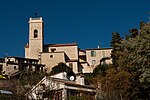Labyrinth (Miró, Joan)
Buildings and structures in Alpes-MaritimesSculpture gardens, trails and parks in FranceSculptures by Joan Miró
Labyrinth is the set of sculptures and ceramics created by the Catalan artist Joan Miró for Marguerite Aimé Maeght, between 1961 and 1981. It is currently located at the Maeght Foundation in Saint Paul de Vence, France.Labyrinth consists of 250 works, mainly sculptures, scattered in a terrace garden overlooking the sea, which illustrate the story of the connection between the Maeght family and Joan Miró. The labyrinth is a walk through the mind and imagination of the artist.
Excerpt from the Wikipedia article Labyrinth (Miró, Joan) (License: CC BY-SA 3.0, Authors).Labyrinth (Miró, Joan)
Chemin des Fumerates, Grasse
Geographical coordinates (GPS) Address Phone number Nearby Places Show on map
Geographical coordinates (GPS)
| Latitude | Longitude |
|---|---|
| N 43.7006 ° | E 7.1151 ° |
Address
Fondation Maeght
Chemin des Fumerates
06570 Grasse
Provence-Alpes-Côte d'Azur, France
Open on Google Maps










